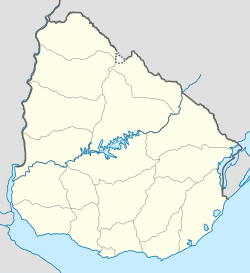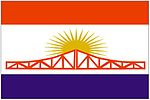The transport network in Uruguay consists of 1,673 km of rail network, 7,743 km of paved roads, 1,600 km of navigable waterways, and 11 airports with paved roads.

Colonia del Sacramento is a city in southwestern Uruguay, by the Río de la Plata, facing Buenos Aires, Argentina. It is one of the oldest towns in Uruguay and the capital of the Colonia Department. It has a population of around 27,000.

Fray Bentos is the capital city of the Río Negro Department, in south-western Uruguay, at the Argentina-Uruguay border, near the Argentine city of Gualeguaychú. Its port on the Uruguay River is one of the nation's most important harbours. The city hosts the first campus of the Technological University, beside the historically relevant industrial complex Anglo, a World Heritage Site.
Río Negro Department is a department of the northwestern region of Uruguay. It has an area of 9,282 km2 (3,584 sq mi) and a population of 54,765. Its capital is Fray Bentos. It borders Paysandú Department to the north, Tacuarembó Department to the east, Durazno Department to the southeast, Soriano Department to the south and has the Río Uruguay flowing at its west, separating it from Argentina.
Banda Oriental, or more fully Banda Oriental del Uruguay, was the name of the South American territories east of the Uruguay River and north of Río de la Plata that comprise the modern nation of Uruguay, the modern state of Rio Grande do Sul, Brazil, and part of the modern state of Santa Catarina, Brazil. It was the easternmost territory of the Viceroyalty of the Río de la Plata.
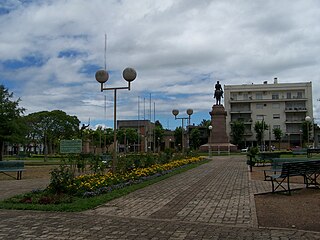
Salto is the capital city of the Salto Department in northwestern Uruguay. As of the 2011 census it had a population of 104,028 and is the second most populated city in Uruguay, after Montevideo.

Colón is a city in the province of Entre Ríos, Argentina. It is located in the east of the province, on the western shore of the Uruguay River, and has about 23,000 inhabitants. It lies opposite Paysandú, Uruguay, to which it is linked across the river by the General Artigas Bridge.

Nueva Palmira is a city in Colonia Department in south-western Uruguay.

Montevideo is a department (departamento) of Uruguay. It is by far the smallest department in area, but also by far the most populated. Its capital is the city of Montevideo, which is also the national capital. While most of the department is covered by the capital city, there are still smaller towns within its limits.

Chuy is a city in the extreme east of Uruguay, in the Rocha Department, 340 kilometres (211 mi) northeast of Montevideo. It lies on the border with Brazil, separated from its Brazilian sister town of Chuí only by a shared avenue that serves as the border, and by the Arroyo Chuy (stream) to the east. Chuy's population was 9,675 in 2011.

Tourism in Uruguay is an important part of the nation's economy.
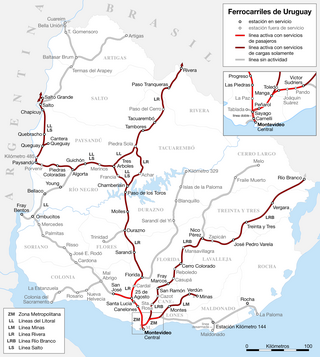
The Uruguayan railway network has about 2900 km (1802 mi) of lines, all of 1,435 mm gauge, diesel traction with only 11 km (7 mi) of double track. Only half of the network is currently active. All the Uruguayan lines start from Montevideo, connecting the cities of Paysandú, Salto, Rivera and Río Branco. The rest of the lines (closed) connected the capital city with Fray Bentos, Cuareim, Artigas, Km. 329, Melo, La Paloma and Colonia del Sacramento.

Conchillas is a small industrial town located within the Colonia Department, in southwestern Uruguay.
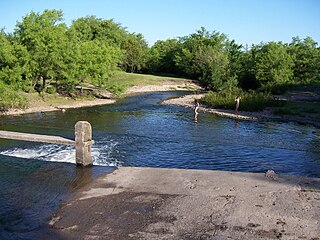
Rosario, also known as Rosario Oriental, Villa del Rosario, or Rosario del Colla, is a small city located within the Colonia Department, in southern Uruguay. It is home to about 10,000 people.

Tarariras, is a small city in the south of the Colonia Department of southern Uruguay.
Juan Lacaze, or Juan L. Lacaze, is a city located in southwestern Uruguay, within the Colonia Department.
Ombúes de Lavalle is a small city located in the north of Colonia Department in southwestern Uruguay. It is named after the Argentine General Juan Lavalle. The term «Ombúes» is the Spanish plural for «Ombú», a tree originary of the Pampas region, in southern South America, and a national symbol of both Argentina and Uruguay.

The Carmelo bridge is a swing bridge located over the Arroyo de las Vacas, near the city of Carmelo, Uruguay. Its turning mechanism is human-powered, which makes it the only one of its kind in Uruguay.
It is considered to be the first swing bridge in South America.
Las Víboras is a Uruguayan town in the Colonia Department which was one of the first towns in the Uruguayan countryside. A substantial portion of its population later became the base of the city of Carmelo.



